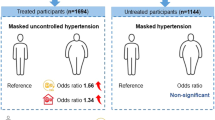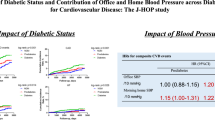Abstract
The association between masked hypertension and metabolic syndrome (MS) or insulin resistance is unclear. We investigated an untreated nationwide population sample (n=1582, age 44–74 years). Duplicate office blood pressure (BP) measurements were taken on one visit and duplicate morning and evening home measurements were taken for 7 days. Masked hypertension was defined as office BP <140/90 mm Hg with home BP ⩾135/85 mm Hg. Logistic regression analysis was used to determine the association between masked hypertension and metabolic risk factors. Age- and gender-adjusted odds ratios for metabolic disorder were 2.89 (1.87–4.47), 2.93 (2.15–3.97) and 1.68 (1.05–2.70) in white-coat hypertension, 3.39 (2.00–5.76), 3.86 (2.61–5.72) and 2.77 (1.63–4.70) in masked hypertension, and 7.38 (5.19–10.49), 6.45 (4.92–8.46) and 4.27 (3.00–6.08) in sustained hypertension using European Group for the Study of Insulin Resistance, harmonised MS and homeostasis model assessment of insulin resistance above the 80th percentile criteria. When home BP was used to define MS, masked hypertension moved close to sustained hypertension. The association between masked hypertension and metabolic disorders was related to home BP, body mass index and waist circumference. In conclusion, home BP appears to be a useful method to assess the risk of metabolic disorder. Masked hypertensives would benefit from the use of home BP in the definition of MS.
This is a preview of subscription content, access via your institution
Access options
Subscribe to this journal
Receive 12 digital issues and online access to articles
$119.00 per year
only $9.92 per issue
Buy this article
- Purchase on Springer Link
- Instant access to full article PDF
Prices may be subject to local taxes which are calculated during checkout
Similar content being viewed by others
References
Pajunen P, Rissanen H, Härkänen T, Jula A, Reunanen A, Salomaa V . The metabolic syndrome as a predictor of incident diabetes and cardiovascular events in the Health 2000 Study. Diabetes Metab 2010; 36: 395–401.
Gami AS, Witt BJ, Howard DE, Erwin PJ, Gami LA, Somers VK et al. Metabolic syndrome and risk of incident cardiovascular events and death: a systematic review and meta-analysis of longitudinal studies. J Am Coll Cardiol 2007; 49: 403–414.
Eckel RH, Grundy SM, Zimmet PZ . The metabolic syndrome. Lancet 2005; 365: 1415–1428.
Alberti KG, Eckel RH, Grundy SM, Zimmet PZ, Cleeman JI, Donato KA et al. Harmonizing the metabolic syndrome: a joint interim statement of the International Diabetes Federation Task Force on Epidemiology and Prevention; National Heart, Lung, and Blood Institute; American Heart Association; World Heart Federation; International Atherosclerosis Society; and International Association for the Study of Obesity. Circulation 2009; 120: 1640–1645.
Mancia G, Bombelli M, Corrao G, Facchetti R, Madotto F, Giannattasio C et al. Metabolic syndrome in the Pressioni Arteriose Monitorate E Loro Associazioni (PAMELA) study: daily life blood pressure, cardiac damage, and prognosis. Hypertension 2007; 49: 40–47.
Sheikh S, Sinha AD, Agarwal R . Home blood pressure monitoring: how good a predictor of long-term risk? Curr Hypertens Rep 2011; 13: 192–199.
Sato A, Asayama K, Ohkubo T, Kikuya M, Obara T, Metoki H et al. Optimal cutoff point of waist circumference and use of home blood pressure as a definition of metabolic syndrome: the Ohasama study. Am J Hypertens 2008; 21: 514–520.
Hänninen MR, Niiranen TJ, Puukka PJ, Jula AM . Comparison of home and ambulatory blood pressure measurement in the diagnosis of masked hypertension. J Hypertens 2010; 28: 709–714.
Hänninen MR, Niiranen TJ, Puukka PJ, Mattila AK, Jula AM . Determinants of masked hypertension in the general population: the Finn-Home study. J Hypertens 2011; 29: 1880–1888.
Mancia G, Facchetti R, Bombelli M, Grassi G, Sega R . Long-term risk of mortality associated with selective and combined elevation in office, home, and ambulatory blood pressure. Hypertension 2006; 47: 846–853.
Björklund K, Lind L, Zethelius B, Andrén B, Lithell H . Isolated ambulatory hypertension predicts cardiovascular morbidity in elderly men. Circulation 2003; 107: 1297–1302.
Hansen TW, Jeppesen J, Rasmussen S, Ibsen H, Torp-Pedersen C . Ambulatory blood pressure monitoring and risk of cardiovascular disease: a population based study. Am J Hypertens 2006; 19: 243–250.
Mancia G, Bombelli M, Facchetti R, Madotto F, Quarti-Trevano F, Grassi G et al. Increased long-term risk of new-onset diabetes mellitus in white-coat and masked hypertension. J Hypertens 2009; 27: 1672–1678.
Hermida RC, Ayala DE, Mojón A, Fernández JR . Sleep-Time Blood Pressure and the Prognostic Value of Isolated-Office and Masked Hypertension. Am J Hypertens 2011; 25 (3): 297–305.
Thomopoulos C, Daskalaki M, Papazachou O, Rodolakis N, Bratsas A, Papadopoulos DP et al. Association of resistin and adiponectin with different clinical blood pressure phenotypes. J Hum Hypertens 2011; 25: 38–46.
Baguet JP, Lévy P, Barone-Rochette G, Tamisier R, Pierre H, Peeters M et al. Masked hypertension in obstructive sleep apnea syndrome. J Hypertens 2008; 26: 885–892.
Lee HY, Park JB . Prevalence and risk factors of masked hypertension identified by multiple self-blood pressure measurement. Hypertension 2008; 52: e137–e138.
Park SJ, Park JB, Choi DJ, Youn HJ, Park CG, Ahn YK et al. Detection of masked hypertension and the 'mask effect' in patients with well-controlled office blood pressure. Circ J 2011; 75: 357–365.
Yoon HJ, Ahn Y, Park JB, Park CG, Youn HJ, Choi DJ et al. Are metabolic risk factors and target organ damage more frequent in masked hypertension than in white coat hypertension? Clin Exp Hypertens 2010; 32: 480–485.
Konstantopoulou AS, Konstantopoulou PS, Papargyriou IK, Liatis ST, Stergiou GS, Papadogiannis DE . Masked, white coat and sustained hypertension: comparison of target organ damage and psychometric parameters. J Hum Hypertens 2010; 24: 151–157.
Asayama K, Sato A, Ohkubo T, Mimura A, Hayashi K, Kikuya M et al. The association between masked hypertension and waist circumference as an obesity-related anthropometric index for metabolic syndrome: the Ohasama study. Hypertens Res 2009; 32: 438–443.
Gryglewska B, Necki M, Cwynar M, Baron T, Grodzicki T . Neurogenic and myogenic resting skin blood flowmotion in subjects with masked hypertension. J Physiol Pharmacol 2010; 61: 551–558.
Grassi G, Seravalle G, Trevano FQ, Dell'oro R, Bolla G, Cuspidi C et al. Neurogenic abnormalities in masked hypertension. Hypertension 2007; 50: 537–542.
Tomiyama M, Horio T, Yoshii M, Takiuchi S, Kamide K, Nakamura S et al. Masked hypertension and target organ damage in treated hypertensive patients. Am J Hypertens 2006; 19: 880–886.
Matthews DR, Hosker JP, Rudenski AS, Naylor BA, Treacher DF, Turner RC . Homeostasis model assessment: insulin resistance and beta-cell function from fasting plasma glucose and insulin concentrations in man. Diabetologia 1985; 28 (7): 412–419.
Balkau B, Charles MA, Drivsholm T, Borch-Johnsen K, Wareham N, Yudkin JS et al. Frequency of the WHO metabolic syndrome in European cohorts, and an alternative definition of an insulin resistance syndrome. Diabetes Metab 2002; 28: 364–376.
Heistaro S . Methodology Report, Health 2000 Survey. National Public Health Institute: Helsinki, 2008.
Niiranen TJ, Jula AM, Kantola IM, Reunanen A . Comparison of agreement between clinic and home-measured blood pressure in the Finnish population: the Finn-HOME Study. J Hypertens 2006; 24: 1549–1555.
Parati G, Stergiou GS, Asmar R, Bilo G, de Leeuw P, Imai Y et al. European Society of Hypertension guidelines for blood pressure monitoring at home: a summary report of the Second International Consensus Conference on Home Blood Pressure Monitoring. J Hypertens 2008; 26: 1505–1526.
Bortolotto LA, Henry O, Hanon O, Sikias P, Mourad JJ, Girerd X . Validation of two devices for self-measurement of blood pressure by elderly patients according to the revised British Hypertension Society protocol: the Omron HEM-722C and HEM-735C. Blood Press Monit 1999; 4: 21–25.
Mancia G, De Backer G, Dominiczak A, Cifkova R, Fagard R, Germano G et al2007 Guidelines for the management of arterial hypertension: the task force for the management of arterial hypertension of the European society of hypertension (ESH) and of the European society of cardiology (ESC). J Hypertens 2007; 25: 1105–1187.
Sillanaukee P, Kiianmaa K, Roine R, Seppä K . [The criteria for heavy drinking. In Finnish.]. Suomen Lääkärilehti 1992; 31: 2919–2921.
Reddy KJ, Singh M, Bangit JR, Batsell RR . The role of insulin resistance in the pathogenesis of atherosclerotic cardiovascular disease: an updated review. J Cardiovasc Med (Hagerstown) 2010; 11: 633–647.
Author information
Authors and Affiliations
Corresponding author
Ethics declarations
Competing interests
The authors declare no conflict of interest.
Additional information
Supplementary Information accompanies this paper on the Journal of Human Hypertension website
Supplementary information
Rights and permissions
About this article
Cite this article
Hänninen, MR., Niiranen, T., Puukka, P. et al. Metabolic risk factors and masked hypertension in the general population: the Finn-Home study. J Hum Hypertens 28, 421–426 (2014). https://doi.org/10.1038/jhh.2013.129
Received:
Revised:
Accepted:
Published:
Issue Date:
DOI: https://doi.org/10.1038/jhh.2013.129
Keywords
This article is cited by
-
Blood Pressure Target Achievement Under Monotheraphy: A Real-Life Appraisal
High Blood Pressure & Cardiovascular Prevention (2020)
-
Epidemiological Impact and Clinical Consequences of Masked Hypertension: A Narrative Review
High Blood Pressure & Cardiovascular Prevention (2020)
-
An Update on Masked Hypertension
Current Hypertension Reports (2017)



